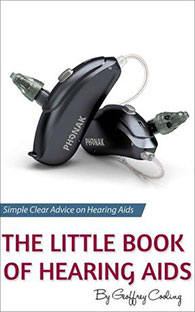This is the first part of my review of my new GN ReSound Linx 3D hearing aids. It looks at the actual devices I received, i.e. what was in the box. You can read the other parts of the Linx 3D review here.
Receiver in Ear - RIE model

I have the LiNX 3D 9 61 receiver-in-the-ear model, this is the first time I have worn this type of hearing aid. They've been available for a while from all the major brands, but I think they were targetted mainly at people with mild to moderate hearing losses. However, as technology has improved they are now available for severe hearing losses like mine.
This style of hearing aid is in two parts: the bit behind your ear contains the microphone and receives the sounds, the bit in your ear, the receiver, pushes the modified sounds into your ear. This is great for a few reasons, it eliminates any chance of feedback (you know, the horrible high-pitched whistling your Granny's hearing aid used to make), it means that the piece of the hearing aid behind your ear can be a lot smaller than with a normal BTE model, and it also means that the wire connecting the two pieces of kit is incredibly thin and invisible unless someone is studying your ear very closely.

Confused About The Right Hearing Aid For You?

Our buying guide, easing the confusion with clear easy to understand info, we guarantee it will help you pick the right hearing aid for you.
Extremely Comfortable

For me, the ReSound RIE is an extremely comfortable fit. A problem I've had with previous BTE hearing aids that I've worn is that the thicker tube running up my ear pushes against my glasses and the top of my ear and was uncomfortable after prolonged wear, whereas the thinner wire of the RIE doesn't take up any space against the glasses at all - so no pressing or problems now. You can see from the picture above that there is a huge difference in size of the tube on the left and the wire on the right.
No pressure in the ear
I've worn a lot of different hearing aids, as my hearing deteriorated over the years I've felt like my options in terms of what I could wear have got smaller because the power that the aid needed to produce to enable me to hear meant I couldn't wear some of the tech designed for more minor hearing losses. For a long while, I've been using a full-shell ear mould, like the one in the picture on the left, this was a way to stop feedback/whistling from occurring. I was happy enough wearing the full ear mould although it did take some getting used to initially, I started off putting it in to my ear slightly wrongly and it pinched against the edge of my ear and caused a cut to open up, which took ages to heal as the mould was always pressing on it and re-opening it.
The Linx 3D doesn't need the full-shell mould and I'm very happy about it! See the picture on the right, I now have a loose-fitting small mould that sits in the canal, is pretty much invisible to most people and lets my ear get a bit of fresh air.
I have to admit I was a little nervous about this to begin with, as it felt like the aid was going to fly off my ear - I'd gone from the feeling of having a full ear and knowing the aid was petty firmly lodged in there to really having a comfortable and loose fit. In the time I've been wearing the ReSounds I have run several 5km races and played 5-a-side football and they have remained safely on my ears the whole time. So no worries there.
Control buttons on the hearing aids

Most modern hearing aids have some kind of control button(s) on them - they'll let you adjust the volume manually and also switch between the different listening modes that they have. These controls can sometimes be difficult for people to use as they are quite small and fiddly.
The controls on the Linx 3D are simple and intuitive to use, and I don't think many people would find it too fiddly as there is only one button on each aid. The Linxs work as a pair to let you change the volume, if you press the button on the right hearing aid the volume goes up and if you press the left hearing aid's button it goes down. To switch between listening modes you do basically the same thing but instead of pressing each button quickly you hold it down for a second or two - holding the right button moves to the next mode, holding the left goes to the previous. In each case, the hearing beeps at you to let you know it has changed volume or mode.
The Linx 3Ds are masters of connectivity with other devices like iPads and mobile phones and they give you a lot more control via these devices - more on this later.
Summary
It's the first time I've worn a receiver-in-the-ear hearing aid and I'm sold on them: small, sleek and comfortable. The Linx 3D has a minimal and simple design that shouldn't be fiddly for anyone to use.
Geoff has covered a lot of detail already about the technical details, the models and the features of the new Linx 3D range. You can take a high-level view on the Resound Hearing Aids page. Or a more in-depth view on the following pages. If you would like to try the hearing aids out, you can find a local hearing aid centre here to allow you to experience them.



